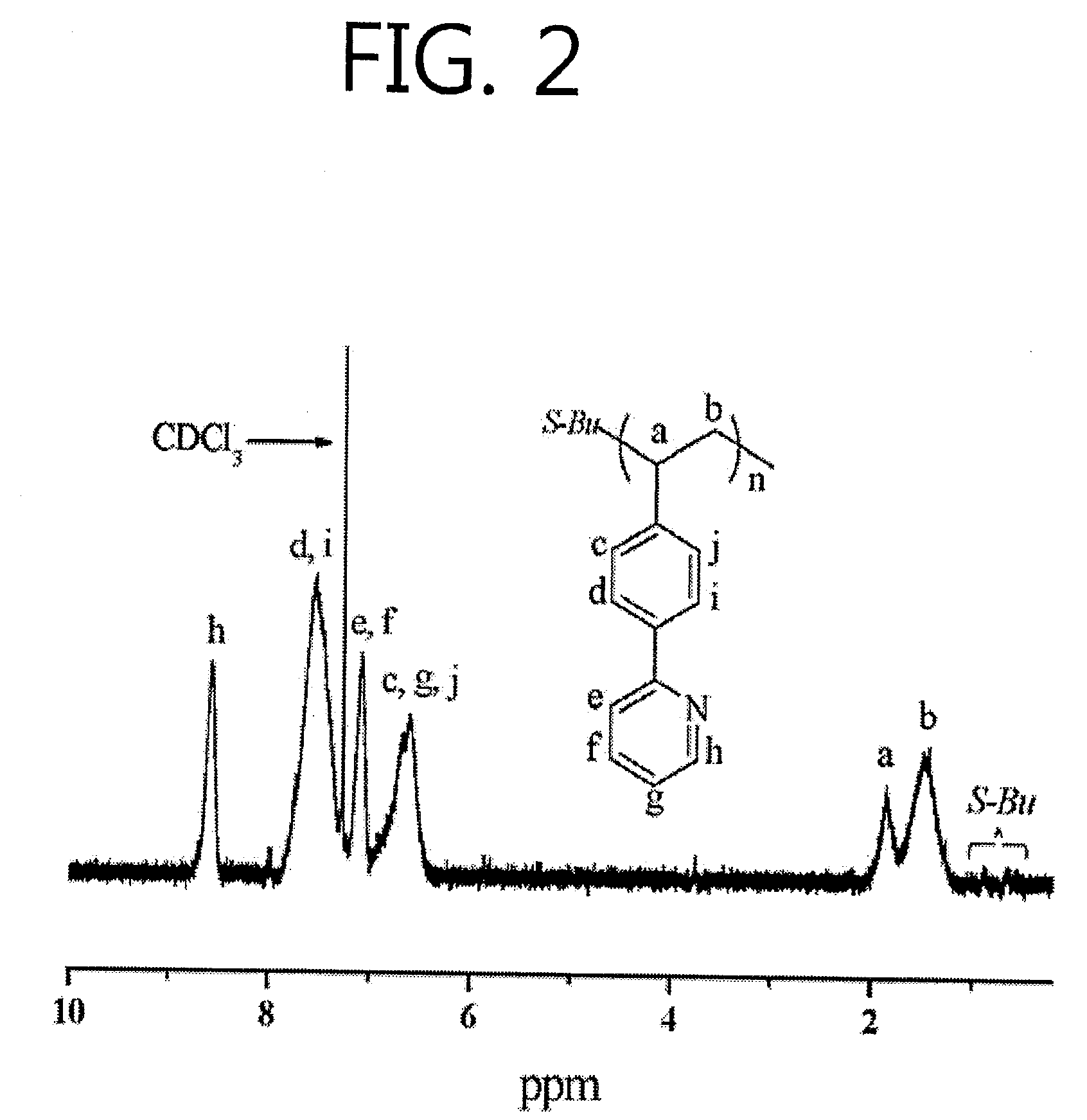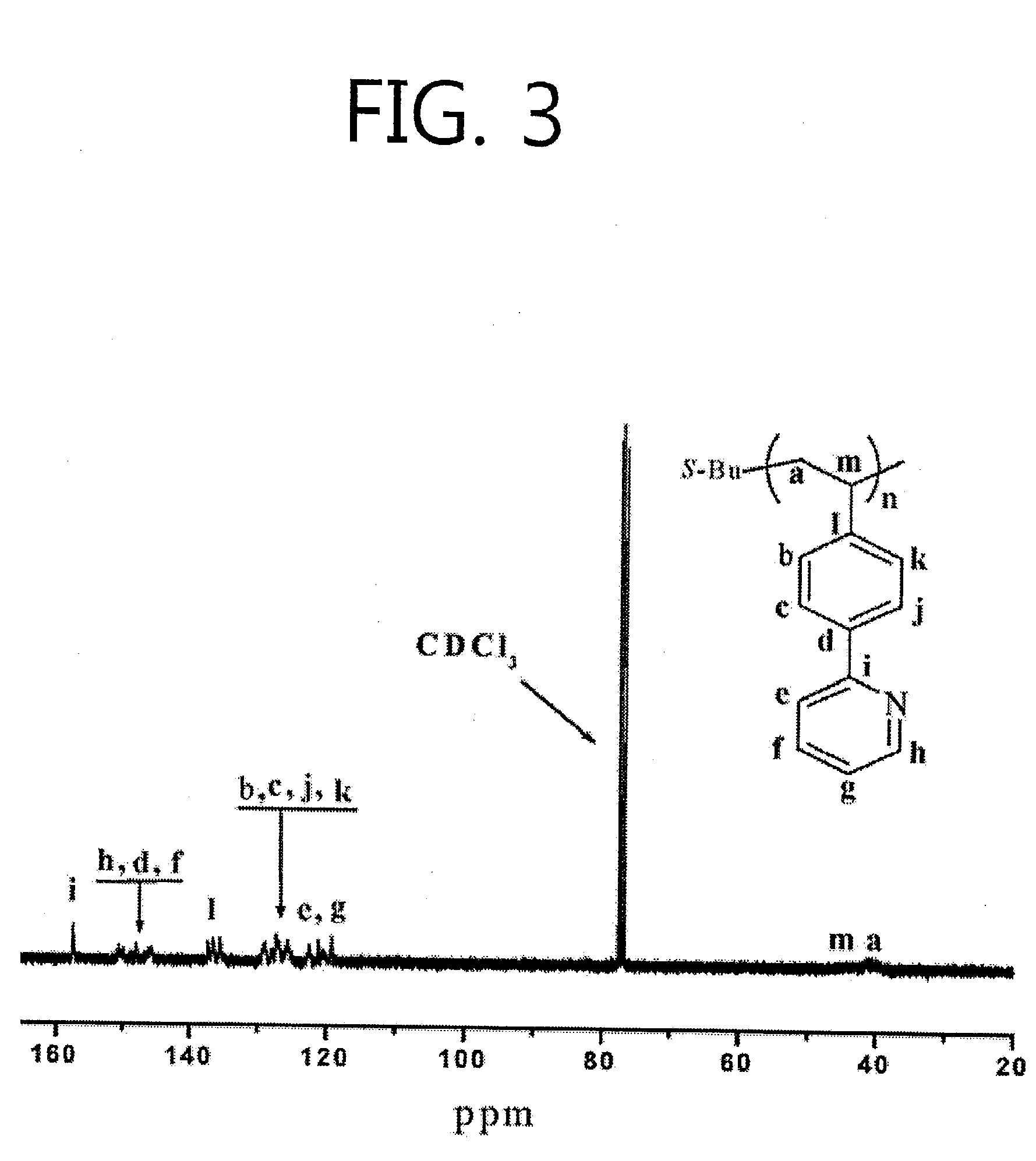Anionic polymerization method for styrene derivative containing pyridine as functional group
a functional group and anionic polymerization technology, applied in the field of anionic polymerization method for styrene derivative containing pyridine as a functional group, can solve the problems of inability to control the molecular weight distribution of the polymer, many side reactions, and low polymer yield or molecular weigh
- Summary
- Abstract
- Description
- Claims
- Application Information
AI Technical Summary
Problems solved by technology
Method used
Image
Examples
example 1
[0053]An anionic polymerization method for a (vinylphenyl)-pyridine monomer represented by Formula I forming a complex with lithium chloride is represented by Reaction Scheme 1-a.
[0054]Here, n is the number of repeated (vinylphenyl)-pyridine monomers and ranges from tens to millions.
[0055]The anionic polymerization method for a (vinylphenyl)-pyridine monomer to which lithium chloride is added includes i) forming a complex of (vinylphenyl)-pyridine and lithium chloride using tetrahydrofuran (THF) as a solvent, ii) initiating polymerization under a first condition by adding an s-butyllithium solution as an initiator to the complex of the (vinylphenyl)-pyridine and the lithium chloride, and iii) performing the polymerization under a second condition different from the first condition.
[0056]The first condition under which initiating polymerization by adding the s-butyllithium solution as the initiator to the complex of the (vinylphenyl)-pyridine and the lithium chloride is performed may...
experimental example 1
Preparation of Homopolymer of poly(2-(4-vinylphenyl)pyridine) Using Lithium Chloride
[0058]Complexes of (vinylphenyl)-pyridine and lithium chloride were prepared with various content ratios of 2-(4-vinylphenyl)pyridine to lithium chloride shown in Table 1 in a glass apparatus under high vacuum. At this time, tetrahydrofuran (THF) was used as a solvent.
[0059]An s-butyllithium solution was added as an initiator to the (vinylphenyl)-pyridine monomers forming a complex with lithium chloride, polymerization was initiated under a first condition, and then polymerization was carried out under a second condition, that is, at various temperatures and for various periods of time for each run according to Table 1.
[0060]After that, methanol was added to terminate the reaction and then removed by filtration. The polymerized product was dissolved in benzyne, filtered to remove lithium chloride and freeze-dried, thereby obtaining the final product polymer.
[0061]In Table 1, s-BuLi is s-butyllithium,...
experimental example 2
Test of Controlling Molecular Weight and Molecular Weight Distribution of poly(2-(4-vinylphenyl)pyridine) According to Lithium Chloride Concentration Change
[0065]FIG. 1 shows a GPC spectrum of poly(2-(4-vinylphenyl)pyridine).
[0066]Referring to FIG. 1, each of the poly(2-(4-vinylphenyl)pyridine) was prepared according to the following description.
TABLE 2VPPy:LiClabcd1:0.261:0.641:0.91:1.4
[0067]Complexes of 2-(4-vinylphenyl)pyridine (VPPy) and lithium chloride (LiCl) were prepared with various content ratios of VPPy to LiCl shown in Table 2. At this time, THF was used as a solvent.
[0068]An s-butyllithium solution was added as an initiator to the (vinylphenyl)-pyridine monomers forming a complex with lithium chloride, thereby initiating polymerization at −78° C., and then polymerization was carried out under a second condition, that is, at −45° C. for 72 hours.
[0069]After that, methanol was added to terminate the reaction and then removed by filtration. The polymerized product was diss...
PUM
| Property | Measurement | Unit |
|---|---|---|
| Temperature | aaaaa | aaaaa |
| Temperature | aaaaa | aaaaa |
| Time | aaaaa | aaaaa |
Abstract
Description
Claims
Application Information
 Login to View More
Login to View More - R&D
- Intellectual Property
- Life Sciences
- Materials
- Tech Scout
- Unparalleled Data Quality
- Higher Quality Content
- 60% Fewer Hallucinations
Browse by: Latest US Patents, China's latest patents, Technical Efficacy Thesaurus, Application Domain, Technology Topic, Popular Technical Reports.
© 2025 PatSnap. All rights reserved.Legal|Privacy policy|Modern Slavery Act Transparency Statement|Sitemap|About US| Contact US: help@patsnap.com



